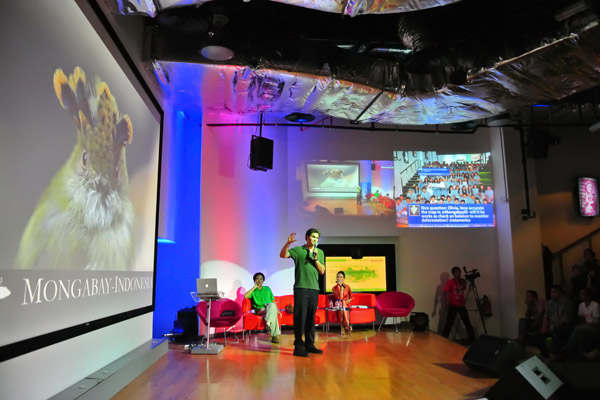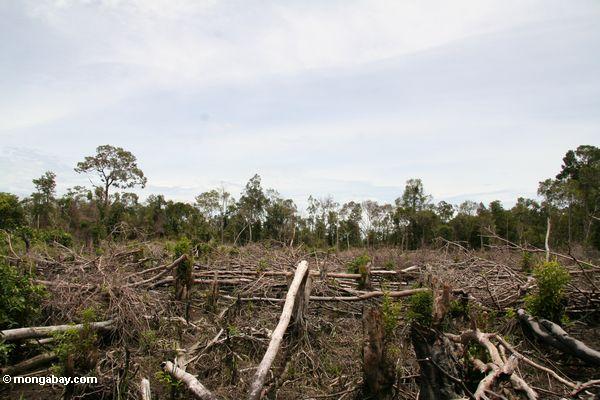Just over a year ago, the Indonesian-language version of Mongabay went live (the official launch was May 19. 2012, but the site was live before that). Mongabay.co.id was the first project under Mongabay.org, the non-profit arm of Mongabay I launched last year. Mongabay.org has three program areas: special reporting projects for non-Mongabay journalists, our environmental education (K-8) initiative, and non-English reporting.
I launched Mongabay-Indonesia as the first project under Mongabay.org because I believe the country is at a critical point in its development history. It has the opportunity to shift from a business-as-usual approach based on forest destruction toward a low carbon model that leverages the things that make Indonesia unique (biodiversity and culture), while improving the lives of all Indonesians.
From an environmental standpoint, I saw Indonesia in 2011-2012 where Brazil was roughly a decade earlier: a high deforestation rate, rampant social conflict, and endemic corruption but emerging private sector interest in cutting forest clearing, growing clout of civil society, improving transparency around land use, and some positive signals at both federal and sub-national government levels. Deforestation in the Brazilian Amazon has since plunged 80 percent, whereas Indonesia’s is still quite high (though down from the Armageddon of 1997-1998). Now of course, Brazil and Indonesia remain very different countries, but I still see these parallels as reason for hope.
Forest clearing in Central Kalimantan. I took this photo during a 2006 reporting trip to Tanjung Puting
In Indonesia one of the key hurdles to making the transition is lack of transparency, which allows business-as-usual interests to continue clearing forests and enables a culture of corruption that permeates the forestry sector. One need look no further than Central Kalimantan, Indonesia’s first pilot province under its Reducing Emissions from Deforestation and Degradation (REDD+) program, for an example. Central Kalimantan, or Kalteng as it is known locally, is presently experiencing one of the highest rates of conversion in the country. The province is also beset by social conflict and corruption, as evidenced by a 2011 audit by the anti-corruption board which found more than 92 percent of plantation and mining companies operating in Central Kalimantan had failed to secure the proper permits. The cost to the Indonesian state is estimated at $17.6 billion over the past 15 years.
The Central Kalimantan findings demonstrate the need to build transparency and strengthen civil society within Indonesia. That’s where the idea for Mongabay-Indonesia entered the picture. Independent and credible on-the-ground gathering and reporting, disseminated via social media (Indonesia has among the highest per capita participation in Facebook and Twitter), can help facilitate efforts to improve management of Indonesia’s natural resources and stewardship of its biodiversity. And thus Mongabay-Indonesia was born.
Launching Mongabay-Indonesia
The first step to turning Mongabay-Indonesia into a reality was lining up funding under my 501(c)3. Armed with a two-page concept note, that process involved about 15 months of knocking on doors. Once a foundation stepped forward and funding arrived at the end of February 2012, I put together job descriptions for three positions — a general manager, a senior editor and writer, and a social media coordinator — and put word out via Mongabay.com and my existing network in Indonesia. From the response — 200+ applications in two weeks — it was clear there was a lot of interest.
Three weeks later and having narrowed the pool to the top 40 candidates, I was in Jakarta for in-person interviews. I did 40 interviews in three days and then set off for a three-day trip to the western tip of Java to visit Ujung Kulon with rangers from the Rhino Foundation of Indonesia to look for signs of the nearly-extinct Javan rhino — I needed a break from interviews. Upon my return to Jakarta I interviewed the top six candidates from the previous round and made my decisions. The first member of the team, general manager Ridzki Sigit, helped with the final personnel decision.
The four team members — I was able to bring on two writer-editors by juggling the budget — started in mid-April. The first post went up April 16, 2012 and by May 1, the team was doing regular posts. Mongabay-Indonesia had its official launch May 19, 2012 at a three-hour event in Jakarta that was attended by over 200 people. By the end of July 2012, Mongabay-Indonesia was one of the most popular Indonesian-language environmental sites. By the end of the year, the site was drawing more than 40,000 visitors per month and had more than 1,000 posts. Surprisingly, Mongabay-Indonesia was getting regular invites to media events alongside Indonesia’s largest newspapers, television stations, and news web sites. It had also built out a network of corespondents to include 14 journalists in 12 cities — all reporting on local social and environmental issues.

Mongabay.co.id launch event in Jakarta on May 19, 2012

Me surrounded by the core Mongabay.co.id team members — Aji, Ridzki, Lidwina (Chea), and Sapariah (Arie) in Jakarta in November 2012
Mongabay-Indonesia has continued to grow in 2013 and I’m excited about where things are headed. The site’s success is due to the hard work of the all-Indonesian team, which will soon expand further. Next month we’re bringing on another core team member and adding more correspondents in regions where we currently lack coverage. We’re also bolstering our off-line efforts, including workshops, university events, and radio and TV partnerships. The next few months promise to be full of interesting developments.
Soon I hope to replicate Mongabay-Indonesia’s model in another language if I’m able to line up funding. Stay tuned for updates.

